Where to go in Switzerland on a short trip: Alps, lakes, and cities
Switzerland is an extremely popular country for those planning multi-stop tours around Europe, yet very few potential first-time visitors actually know specifically where they want to go. Everyone seems to know that it has the most beautiful views of the Alps and some very impressive cities, but there are actually many misconceptions among casual trip planners, so I’d like to clear most of that up below. The places to visit in Switzerland are not obvious until you’ve been there yourself or done many hours of research, so the list below should be a short cut.
I get hundreds if not thousands of itinerary questions for people who are considering a Eurail trip around Europe, and most people just include the word “Switzerland” among a list of cities like Paris, Rome, and Berlin that they want to visit. So where in Switzerland should you go if you can only make a few stops at most? I’ll answer that question below. You’ll mostly want to focus on the best choices for Swiss Alps trips, which I’ll go over below.
Note: This article was expanded and updated in February, 2024.
Switzerland is about outdoor views rather than city visits
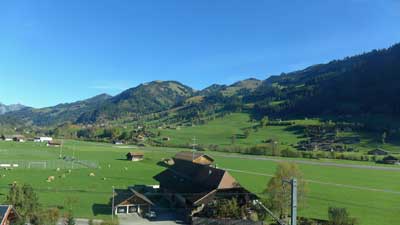
Geneva is a very famous city (though not for tourism reasons) on a lovely lake of the same name, but it’s also notoriously dull and lacking distinction. Rick Steves puts it well by saying that “Geneva is pleasantly situated on a lake, like Buffalo or Cleveland.” The point is, you don’t want to go to Geneva unless you’ve got something specific in mind that you want to see there. There are much better places to visit in Switzerland if your time is limited, or even if it’s not.
Switzerland's cities in summary
Zurich – The largest city, very expensive, geared towards business travelers. It’s generally a pretty and very well-run city that you would enjoy if you visited, but it’s not nearly as interesting as the likes of Vienna, Munich, or of course Paris.
Geneva – Second largest city, in the French part of the country, no major sights. Again, if you visited you’d be very impressed by it and get some great photos, but it’s not worth your time unless you know someone there. There’s an impressive fountain in the lake and you can usually see it from the train as you go through the city, but it’s not really worth going there and staying more than an hour or so.
Basel – Bordering France and Germany, no major sights. It has the famous art market each year, and aside from that it’s even duller than the ones above. Again, if you visited you’d be impressed, but if you later compared photos with friends who went to the Lauterbrunnen Valley instead, you’d kick yourself for going to Basel.
Lausanne – Near Geneva in the French part of the country, very hilly, and certainly more interesting than Geneva.
Bern – The capital, compact, on a lovely river, some interesting sights and the best Swiss city to get a feel for the culture. Bern is fairly close to Interlaken (which we will discuss below) and it can be a great day trip from there, especially on a day where it is foggy and/or rainy in the mountains (and this happens a LOT).
How much time and which Swiss cities to visit?
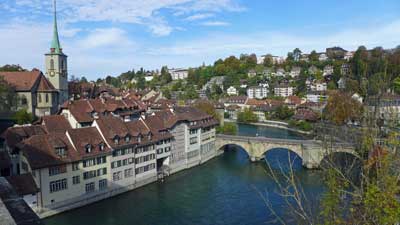
Many people (me included) don’t feel as if they’ve scratched the surface of a new country if they haven’t spent at least a day or two in the largest city. Zurich is certainly pleasant and a useful transit hub so spending one or two nights there wouldn’t be a major mistake. But Zurich isn’t even close to being a city like Paris, Rome, Berlin, Amsterdam, or even Vienna. If you skip it in favor of spending more time in the Swiss Alps, you won’t be missing much.
The 2 Best places to visit in Switzerland for short visits
Interlaken – If you want the best possible Alpine views and activities, head to the Interlaken area, which will be described in detail below. This is my favorite of all places to visit in Switzerland and it will probably be yours as well.
Lucerne – The traditional Swiss tourist retreat, Lucerne is a small city with interesting culture and sights, that is gorgeously set on a lake with plenty of top activities surrounding it.
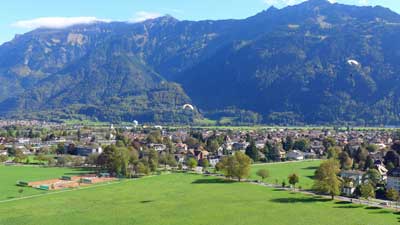
>>>Interlaken and Lucerne: Which to choose and how long to stay in each?
The article linked above will give you more details on which to choose and how long to spend in each place.
What about Zermatt for Alpine views?
Zermatt is a remote car-free village in southern Switzerland that is famous for being the place to see the Matterhorn mountain. It’s also a busy ski resort area, and aside from that, there isn’t much to see or do here. It’s on a private rail line, so it’s more complicated and usually more expensive to reach than Interlaken.
In other words, unless you’ve irrationally placed “Seeing the Matterhorn in person” on your so-called bucket list, skip Zermatt and head to Interlaken on a shorter visit. You won’t be sorry. If you already have enough time in your visit for the main sights around Interlaken and Lucerne and you want to also see the Matterhorn, then by all means go and you’ll enjoy it. There are quite a few other car-free villages in the Lauterbrunnen Valley near Interlaken, so they are not as novel in Switzerland as one might expect.
A weekend in Switzerland? What to see in 3 days
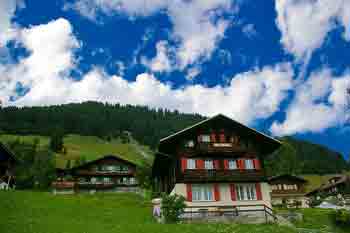
One challenge is that neither has an international airport so you’ll either be flying into Zurich or perhaps Geneva.
Train times from Zurich to Lucerne to Interlaken and back
- Zurich Airport to Lucerne: 1 hour 10 minutes by train
- Lucerne to Interlaken: 2 hours by train
- Interlaken to Zurich Airport: 2 hours 15 minutes by train
As you can see with the travel times above, Zurich Airport to Lucerne is a fairly short trip, but once you add Interlaken into the mix (even if you skip Lucerne) the travel time starts to add up for a weekend visit. With this in mind it’s probably best to just choose one of them and save the other one for another trip.
Lucerne is gorgeous, but the Lauterbrunnen Valley near Interlaken is really the star of the show, so I’d recommend going there first and doing Lucerne on another trip.
What about the Swiss Travel Pass?

The bottom line is that if you are coming to Switzerland for at least 3 days and you want to take 2 or more of the amazing scenic rail journeys that the country is famous for, the travel pass is probably a good deal. It also provides 50% discounts on the Schilthorn cable car and 25% off the Jungfraujoch mountain railway. Both of those are quite expensive on their own, but extremely worthwhile, so the discount is helpful.
The Half Fare Card is probably a better deal for most people
The Swiss Travel Pass is a good deal for those who are going to be spending at least 2 or 3 days riding the rails and seeing Switzerland that way. But if you are mostly going to be focusing on Interlaken and Lucerne and the mountain sights, the Half Fare Card is the best option. For CHF120 (about US$134) you get the card that is good for 30 days and gives you a 50% discount on all trains, cable cars, mountain railways, and other sights and attractions. If you are doing either Schilthorn or Jungfraujoch, the Half Fare Card practically pays for itself with just one of those.
>>>Buy the Swiss Half Fare Card
Many people have questions about the Swiss Half Fare Card so I will explain it a bit here. You can actually buy half price train tickets for travel within Switzerland any time you want and you will see that option when you go to buy them online. The only thing is you have to have and present a valid Half Fare Card when you get on the train and are asked to see your ticket. In other words, you can buy a half fare train ticket today and buy a Half Fare Card just before you get on that train months in the future, and you are fine.
How and why visit the area around Interlaken
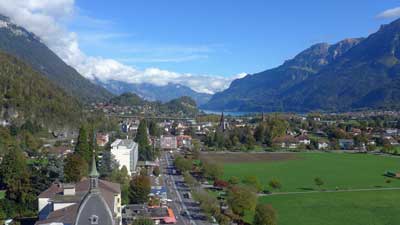
You can see everything discussed below by actually staying in a hotel in Interlaken, but it’s not the Alpine experience that you get if you stay in one of the small villages nearby. You can reach those villages in 20 to 40 minutes from the Interlaken Ost (East) train station, and it’s much easier than it sounds.
The 3 best places to stay to visit the Swiss Alps
Lauterbrunnen – A private train line runs from Interlaken Ost station to the end of its line in Lauterbrunnen. There’s a lovely waterfall here and great hiking trails, but you should probably only stay here if you can’t get to one of the villages mentioned just below. It’s a great little transit hub and it’s definitely gorgeous, so it can be worth a night if you’ve got one to spare.
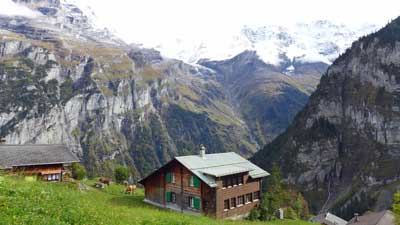
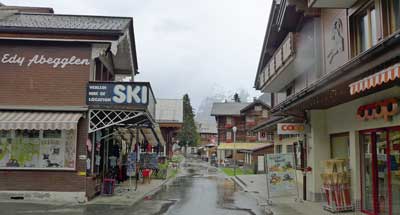
Where to stay in Interlaken and the Lauterbrunnen Valley (with pics)
I get so many questions about where to stay in the Interlaken area that I decided to write a longer version of it and load it with huge photos so readers can get a better feel for each option. I also included recommendations for affordable and well-located photos in each area.
>>>Where to stay in Interlaken and the Lauterbrunnen Valley New for 2024!
The unforgettable things to see here (if the weather is decent)
Schilthorn observation deck and restaurant
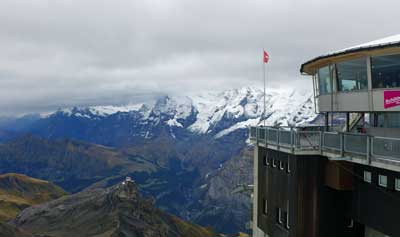
There is a rotating restaurant (with prices similar to normal Swiss restaurants) and a bizarre and anachronistic James Bond attraction based on it being a key location in the 1969 movie On Her Majesty’s Secret Service. The Bond thing is included with the lift, and it’s worth a look.
But the main thing you come here for is the 360-degree view from one of the highest peaks in Europe. Again, the weather here is key, but fortunately all the locals track the visibility on a minute-by-minute basis. If it’s clear up top while you are in the area, it would be a terrible shame to skip it based on the high price. But even if it’s cloudy up top, there are still plenty of wonderful things to see and do in the villages below.
Jungfraujoch observation area
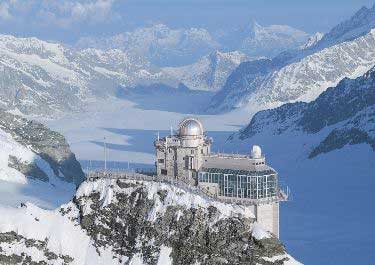
The views from the top are similar to the views from Schilthorn, from the other side of the Lauterbrunnen Valley. Once on top you can have lunch, hike, or even go sledding. It’s also quite expensive at nearly US$200 round-trip unless you have a Swiss Pass or a Eurail Pass for discounts, and it takes most of your day, but you’ll never forget the views from the top.
Harder Kulm mountain and Two Lakes Bridge Observation Deck
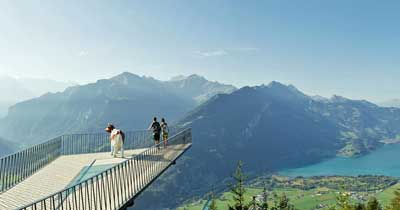
There’s a revolving restaurant about 10 minutes’ walk from the station at the top, which is definitely an unforgettable place for lunch if you’ve got time. It’s not as expensive as you might expect, at least compared to normal restaurants in Switzerland.
The Harder Kulm Railway goes from early April through late November each year. If you are only in Interlaken for one day and/or you are on a strict budget, this is the fastest and best way to get amazing Alpine views in the area.
Getting from Interlaken to Gimmelwald and Mürren
Getting up to these villages sounds complicated and time consuming, but it’s actually fast and easy once you get there. This little guide should help.
Arrive in Interlaken
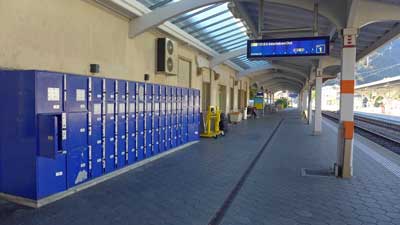
Once you arrive at the Interlaken Ost train station, head for the ticket windows in the office and buy a ticket to your final destination (Lauterbrunnen, Gimmelwald, or Mürren). Eurail passes are good for 25% discounts on the rest of the trip, but not for the whole thing.
From Interlaken Ost to Lauterbrunnen
The private train leaves Interlaken Ost every 30 minutes and arrives in Lauterbrunnen 20 minutes later. If you are staying in Lauterbrunnen then you are probably walking distance from your hotel when you reach the station.
From Lauterbrunnen to Gimmelwald
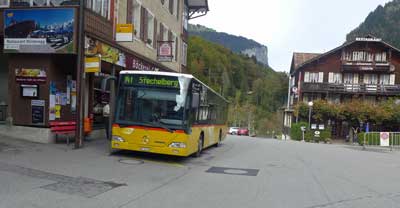

From
Gimmelwald to Mürren
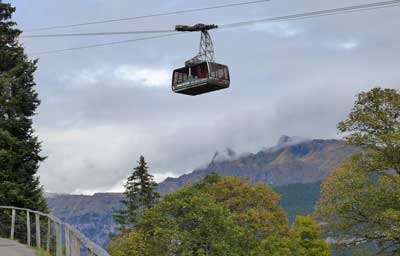
Recommended hotel and hostel in Gimmelwald
I get asked all the time about where to stay in Gimmelwald, so here it is:
Hotel: Esther’s Guesthouse
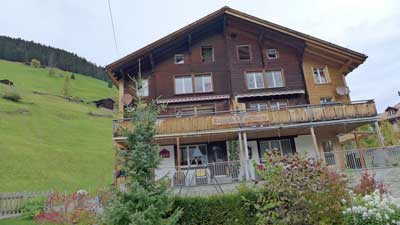
It’s run by Esther, as you might guess, and she is very friendly speaking excellent English. Each room is different and the place feels like a mountain cabin, because it is. She offers an excellent buffet breakfast in the morning, which you have to order the night before. It’s not cheap, but it’s worth it because it’s hearty and there are no other good options nearby.
Book as early as possible because this place is often the first place to sell out in Gimmelwald.
Hostel: Mountain Hostel Gimmelwald
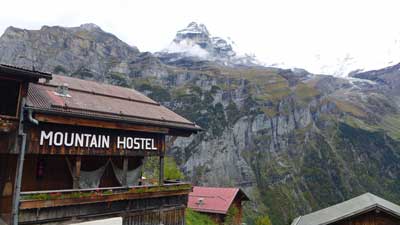
You won’t believe the views from this place, which are the same as from Esther’s except a bit lower and more unobstructed. This place also has a busy bar and restaurant that is basically the only “nightlife” in Gimmelwald. Many hikers get to bed early in this tiny village, but if you want to have a couple drinks and order a pizza or some local options, this is the place to go.
Again, book early because this place is always sold out.
Lucerne and what to do there
Luzern, as it’s spelled locally, is the other traditional holiday destination in Switzerland. Unlike Interlaken, Lucerne actually qualifies as a small city rather than a small resort town, so it’s a very nice contrast and very worthwhile. We have a new article with advice on where to stay in Lucerne and it should be helpful.
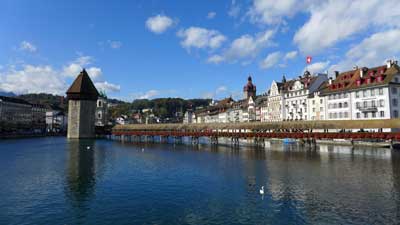
However, unlike Interlaken, the town of Lucerne itself is a great attraction and worth at least a day of exploration. This has always been a rich area so you can expect to find all of the high-end shops and boutiques along the small streets just north of the lake, but there are also many traditional shops and things to see that will appeal to anyone.
Recommended hotel in Lucerne
>>Hotel Des Alpes (3 stars with an amazing location and view)

If this place is booked, which is often the case, then book a hotel as close to it as you can find or afford. The whole historic part of town surrounding it is lovely, with restaurants, bars, and high-end shops. There are also a couple of nearby supermarkets where you can buy inexpensive alcohol and picnic supplies to keep other costs down.
Spend a day in Lucerne itself
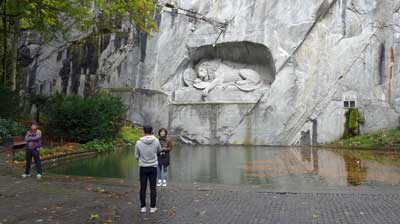
Most of the interesting part of Lucerne is in the area behind those restaurants, and it’s certainly worth doing a self-guided walking tour if not a guided one. Heading farther east you’ll come to another older part of town where the famous lion statue is located. You can’t visit Lucerne without having a look at the lion, and fortunately it’s easy and quick to reach (and it’s free).
Take a lake cruise of some kind
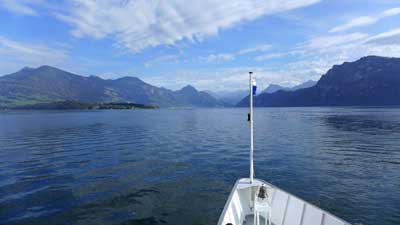
Especially in nice weather, even the short lake tour is lovely, and if you have more time you can jump off at Vitznau and do the scenic hike up Mount Rigi. There are also small lakeside villages that are ideal for a stroll and lunch stop. Long story short, there are dozens of interesting sightseeing options that are available using part of the boat tour, and the views all around are wonderful.
Visit Mount Pilatus
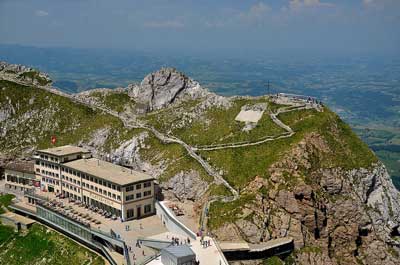
You can take the cogwheel train up and have a more or less flat hike around the summit area, and then take the gondola and cable car back down again. You can do them in the other order, and the cost is the same either way. At around US$65, this is not a cheap hike, but like most everything in Switzerland, the quality is high so it doesn’t feel like a rip-off. You can reach the cable car in 10 minutes on a public trolly bus from Lucerne.
Visit Mount Rigi
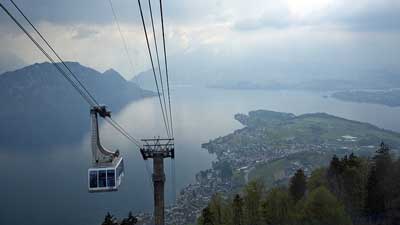
Unlike the other peaks mentioned in this article the Swiss Travel Pass covers both ways to get up and down for free. The others are 50% off with the Swiss Travel Pass or Half Fare Card, except for Jungfraujoch, which is only 25% off with the Swiss Travel Pass and still 50% off with the Half Fare Card.
Visit Mount Titlis
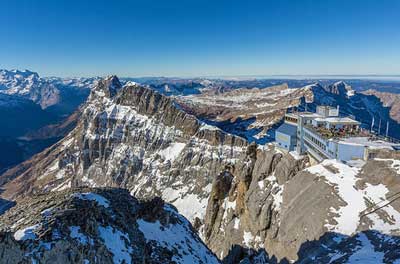
You can reach Titlis by taking a 43-minute train ride from Lucerne to Engelburg and then taking the cable car up from there. As with the others, it’s wise to check the weather immediately before you are going to depart because it can be foggy or cloudy any time of the year, but usually not for whole days at a time.
Additional photo credits
Jungfraujoch by cupweuro on Flickr, Pilatus by Tony Fernandez on Flickr, Rigi by Kosala Bandara on Flickr, Titlis by PaulSchliebs on Flickr

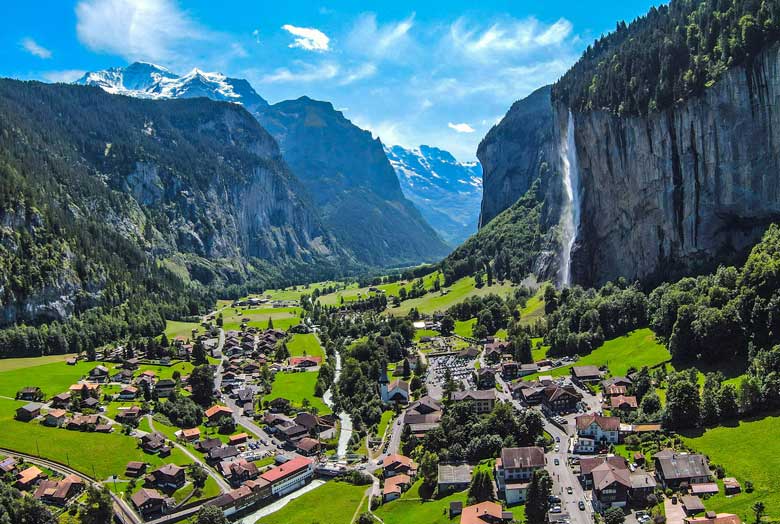
Hi Roger,
Thank you so much. I really appreciate your help. Your blog is really helpful for the ones who plan to travel to Swiss. I just have prepared following plan and have still some questions:
Day 1(May 31st): Rhine falls, Lucerne just on the way City monuments that i mentioned. Stay at some where on the way o Mount Pilatus or in Lucerne sorrounding.
Day 2 (June 1st): Mount Pilatus and Mount Titlis
Can we cover both of them on single day and stay at Interlaken may be near to Jungfrau. Is that possible?
Day 3 (June 2nd): Jungfrau
Considering your suggestation we thought top travel to both Jungfrau and Schilthorn. Where do you recommend us to stay that night considering next day we travel to Schilthorn?
Day 4(June 3rd): Schilthorn
Day 5 (June 4th): May be surrounding Interlaken Lakes and all.
Can you recommend us where to stay ?
Day 6(June 5th): Travel back to Munich.
Do you think should i do some modifications in the plan or is that ok?
Kishore,
Doing Pilatus and Titlis might be possible in the same day, but I don’t think I’d recommend it. Each of them is typically a half-day attraction, so rushing to one and then rushing to the other would be your whole day. There are so many other things to see and do if you can go a bit slower. But again, you could do it if you were determined and started early enough.
The trains from Lucerne to Interlaken take about 2 hours and they leave once per hour until 23:00 each evening. So you could definitely make it to Interlaken or even to Lauterbrunnen on that same day if you like. You could stay somewhere near the Interlaken Ost train station or in Lauterbrunnen or in Grindelwald (not Gimmelwald), and you’ll be right on the Jungfraujoch route in any of them.
The next night you should stay in Gimmelwald or Murren, which are both discussed in the article above. Gimmelwald is a tiny farming village (and stunning) that is the first stop up the cable car up to Schilthorn, and Murren is a much larger skiing town that is the second stop. Murren has far more hotels, but Gimmelwald is more charming.
On that next night you could stay somewhere in Interlaken itself, close to either the Ost (east) or West stations. There are more hotels and restaurants near the West station, but the Ost station is more of a transit hub. There is plenty to see and do in and around Interlaken, so either of them would work well. Your plan is quite ambitious, but it should work and the sights you are visiting are amazing. Let me know if you have any other questions. -Roger
Roger, your recommendations were very good and we have been working along those lines since. Thank you very much!
With regard the Golden Pass from Lucerne to Montreaux, there are a few 5-8 minutes connections on the timetable at http://www.goldenpassline.ch/wp-content/uploads/2016/12/Timetable_GPline_2017.jpg. For example we get into Interlaken Ost at 10:55 on the IR and the next train out is an IC at 11:00. Should we expect to be able to make those short connections?
Is the any place along the way that you recommend we stop at for something to eat or for a break? We will be heading on to Geneva after Montreaux.
During our stay in Gimmelwald, we will be going to Jungfraujoch. Do you recommend going up one the mountain one way and down the other? It seems that adding Grindewald in on the way back to Gimmelwald might add a lot more time.
Thanks again, Joseph
Hi Rogger,
Thanks for your blog. It is really helpful.
Me and my wife is planning to visit Switzerland on the last week of May.
My plan is like below
23.05: Reach Basel and directly to Lauterbrunnen (Stay)
24.05 : Day trip to Gimmelwald,Murren and Schilthorn back to Lauterbrunnen (Stay)
25.05 : Day trip to Jungfraujoch back to Lauterbrunnen (Stay)
26.05 : Move to Lucerne and visit city whole day (Stay)
27.05: Day trip to Mount Pilatus and some night life
28.05: Move to Basel and fly back
Is the above itinerary good? or should I change something?
please suggest.
Should I take any Rail pass? Will it help?
Any place you want to add?
Looking for your help
Sincerely,
Raj
Raj,
Your plan looks very good. The trip from Lauterbrunnen to Schilthorn back to Murren and walking down to Gimmelwald before taking the cable car back down should take maybe 5 hours or so, assuming you spend an hour or two at the top. So you’ll have time to do something more on that day. Jungfraujoch takes maybe 6 or 7 hours back to Lauterbrunnen, so you’ll have a bit more time there as well.
There isn’t much nightlife in Lucerne, but there are plenty of restaurants and bars along the lake that are really nice that time of year.
I think your best bet will be to buy the Half Fare Card for CHF120 per person. I explain it on my article about the Swiss Travel Pass. It will be better value for you than the Swiss Travel Pass itself, since you can use it for 50% off all of your train trips and mountain trips. The main travel pass is only good for 25% off Jungfraujoch, which is also the most expensive thing.
It looks like you are hitting the best highlights. And as mentioned, you’ll have a few extra hours each day after you do your main thing, but you’ll have no trouble filling those hours with something really interesting once you are there. I think you are on the right track. Let me know if you have any other questions. -Roger
Is there anyone here, with knowledge/experience of Interlaken and the surrounding areas, who would be willing to have a conversation with me helping me plan a trip out there this summer? Would be hugely appreciated
Matthew,
I’ve spent time in the Interlaken area and have researched many places that I’ve yet to visit. Feel free to ask a question here and I’ll take a shot at it. -Roger
Hi Roger,
We are husband and wife planning to travel to Swiss from Munich (Germany) from may 31st to june 6th. We have following queries:
1. We are totally confused about firstly our means to reach Swiss, we thought to rent the car and come as it may be little flexible. But we read your blog and understood we cannot travel by car much and need to go by cable cars. So what do you suggest, is it still worth to come by car or do you suggest to come by public transport like bus/train.
2. Our itinerary is as follows (may be in this we assumed we have car):
31st May – Rhine falls
Lucerne – KapellBrucke and Lion monument
1st June – Mount Pilatus
Mount Titlis
If you think first day is too much and we require more time in Rhine falls, we will visit only Rhine falls and go to Lucerne and halt that night. Next day we cover may be Kapelbrucke and Lion monument and go to Mount pilatus and halt there and next day see Mount pilatus and Mount Titils.
2nd/3rd June – We could spend rest time in Interlaken. We saw 2 routes, one through Jungfrau and other Shillton route. Which do you think is better? We stay till 6th morning and then we travel back.
Do you think this Itinerary is fine? Any suggestions/Changes will be really helpful
3. Do you suggest some budget accommodation in these places. Found few but really expensive 🙁
4. What kind of ticket (Like swiss pass etc) do you suggest will help us in this Itinerary.For how many days do you think we need to buy with and without car. Do you suggest us to buy online or come and buy there?
Your suggestions/inputs are highly appreciated.
Thank you in advance
Kishore
Kishore,
I’ll try to answer your questions in order…
1. If you have access to a car then using it to visit Switzerland is not a bad idea. I don’t recommend driving on most Europe trips, but in Switzerland most people want to visit smaller towns such as Interlaken, and parking there is relatively easy. You don’t want to drive around larger cities, though driving between villages and into mountain areas is pretty easy. There are a few places that you have to reach by cable car, such as Schilthorn or any of the villages along the way including Gimmelwald and Murren. But you can park in the cable car lot, and as long as you stay in a hotel with its own parking lot, you should be fine. The trains in Switzerland are fantastic, although a bit expensive. You can go just about anywhere on a train or a bus or a cable car.
2. From Rhine Falls to Lucerne it’s only 107km, which takes a bit over an hour on the toll road. The Chapel Bridge in Lucerne is right in the middle of town so you’ll be seeing it whether you try to or not. The Lion statue is about a 10-minute walk from the Chapel Bridge, so that’s easy as well. You should have time to do all of those things and perhaps also a boat ride on the lake.
The two major summit attractions near Interlaken are the Jungfraujoch tourist train, which takes at least half a day getting you to the highest train station in Europe and back down. The other is the Schilthorn observation deck, which is reached by a 1-hour cable car ride up from Stechelberg near Lauterbrunnen. Both are quite different and very spectacular, and expensive, though worth it. You can do Schilthorn in 4 hours or less and it’s a bit cheaper than Jungfraujoch, and more comfortable as well. Do both if you can afford it and have the time. If you have to pick just one, you can’t go wrong with either of them, but hopefully you can be sure of the weather at the top before you buy your ticket because it can be foggy or rainy, even in summer.
Your itinerary looks quite good and I’m sure you’ll have time for all of it. You’ll have time for more things as well, and a guide book for Switzerland would be money well spent to help you choose the best things and see them in an efficient way.
3. The Mountain Hostel in Gimmelwald is probably the cheapest place in the Interlaken area, and the view is perhaps the best hostel view in the world. Aside from that, it’s just an expensive country and if you found a hotel that charged only, say, US$80 per night, it would have a terrible location and other problems as well. Switzerland is a splurge, unfortunately. The good part is that when you get there you’ll be glad you spent the extra money because there is no other place like it.
4. If you are driving your own car and you still want to do some of the mountain attractions and take a few short train rides, the Half Fare Card that I discuss in the Swiss Travel Pass post would be best. It costs CHF120 for 30 days and everything is half price using it. Just Jungfraujoch and Schilthorn will cost about CHF280 between them, so at CHF140 and a CHF120 card, you are already ahead. Pilatis and Titlis are cheaper, so the half price card will work on those as well.
Let me know if you have any other questions. -Roger
[email protected]
Hi Roger! Let me start by thanking you for taking time on writing your post for it is the only post that makes sense and actually helps us first timers in Switzerland.
So you encompass everything I look forward to seeing in Switzerland weather permitting. With that being said, can you please be so kind to help me with some questions?
We’ll be arriving on April 13th at 3:30 pm to Zurich and we’ll be leaving on April 16th at 7:00pm.
We want to do Gimmewald and weather permitting Schilthorn and Jungfraujoch.
So my questions are:
1) is it worth paying the Swiss pass if I’m only using it to get from Zurich to interlaken and viceversa?
2) how much is the ticket from interlaken to Gimmewald? Does the Swiss pass offer discount for this ticket?
3) if I’m staying in Gimmewald, do I have to pay a new cable at ticket to Schilthorn?
Thank you so much for your time and help, it really is greatly appreciated.
Sincerely,
Natalie
Natalie,
You are welcome and I’m happy that people find this useful.
1) The Swiss Travel Pass would not be good value for you if you are only doing those shorter trips and also using it for the discount on the summit attractions (Schilthorn and Jungfraujoch), but the Half Fare Card that I discuss in the main Swiss Travel Pass article should be a big help.
2) The current price for Interlaken to Gimmelwald is about CHF17 each way. That includes the train from Interlaken to Lauterbrunnen, the bus from Lauterbrunnen to Stechelberg, and the cable car up to the Gimmelwald stop, which is about CHF5 by itself.
3) Each cable car segment is its own ride. From Gimmelwald you have to take a cable car up to Murren and then another one up another stop, and then one more up to Schilthorn. So a ticket from Gimmelwald to Schilthorn is about CHF5 cheaper than a ticket starting in Stechelberg. That Half Fare Card will get you a 50% discount on all of these things, including Jungfraujoch, so it will easily pay for the CHF120 it costs to buy. Have a great trip. -Roger
Hi Roger,
We are family with 2 kids( boy 6 , girl 3 yrs). We are planning to visit Switzerland from Canada for one week in May 17 to May 23 2017. Our in/out flights are via Zurich, but I need to close to Geneva for 22-23 May. I am fan of driving in country roads. What do you offer in terms of stay and driving in 1 week stay in Switzerland?.
Mahdi,
Whether you are driving or taking trains, my suggestions are pretty much the same. If you have to spend a night or two in Geneva then that will be okay, but I’d recommend spending most of your time in Switzerland in the Interlaken area as well as Lucerne for a day or two. Many of the hotels in Interlaken have free parking lots, so it’s a pretty good base to take driving trips to nearby villages and sights. Some of the towns up in the mountains such as Gimmelwald and Murren are closed to cars, but you can park in the lot for the cable car below.
As long as you minimize time in the larger cities, you’ll find Switzerland to be an easy and enjoyable place to drive. Let me know if you have any other questions. -Roger
Hi Roger,
The forum has been great and as seen, loads of people really do value your inputs. Likewise I am also looking to travel with my husband and child with the intent to see the nature that Switzerland has to offer.
I have pour through several options but would like to seek for your advice on the below plans.
We are on a 15 day trip during late December (last two weeks of December)
Reaching Zurich and staying for a night
Heading to Lucerne (or a choice of Basel as a base) for 4 nights so that we can do day trips to Bern or Basel (wanting to catch the christmas market)
Head to Interlaken (2 nights)
Grimmawald (2 nights)
To Montreux (4 nights) (Over Christmas day)
Back to Zurich
Your help is greatly appreciated.
Lisa,
Your plan sounds quite good and most people would love to spend that long in Switzerland. It’s such an expensive country (even compared to its neighbors) that most people only allow 3 or 4 days.
Lucerne is a far better base than Basel (my brother lives literally just over the border from Basel in Germany, and it’s a pretty dull town). Lucerne is gorgeous. Hopefully you can find a Christmas market in Bern or perhaps even Lucerne, as both of those cities are far more interesting.
And again to be clear, the tiny farming village on the way up to Schilthorn is called “Gimmelwald.” There is a much larger (and also nice) ski town not far away called “Grindlewald” and it’s easy to confuse the two. Let me know if you have any other questions. -Roger
Thank you Roger. Indeed it is expensive but we have fallen in love with the country and its beauty during his ultras that we just had to do the long trip. Thank you for the note on Gimmelwald. We definitely are heading there. 🙂
Once again, thank you for the inputs. It really help to firm up the mind.
Hi Roger, thanks a lot for your valuable inputs. I would really appreciate if you could help me with your comments on the following itinerary :
Day 1 – arrive at Interlaken from Paris and do Mt Schilthorn
Day 2 – Junfrauoch
Day 3- city tour of Berne and back to Interlaken
Day 4 – depart for Lucerne and Mt Pilatus
Day 5 – Mt Titlis and city of Lucerne
Day 6 – depart for Zurich . City tour of Zurich.
Kindly let me know if the above itinerary looks fine and I’d something can be added or need to be altered.
Since I would be coming from Paris and assuming I need to undertake the travel for above mentioned itinerary, does the Swiss pass make sense for us . We are a family of four including two kids.
Nawal,
Your itinerary looks excellent and well planned. You’ll have to leave Paris early in order to do Schilthorn on the same day, but it can be done. If you take the 7:23 departure from Gare de Lyon you could be on the cable car up to Schilthorn by around 2pm. Book your international train tickets as soon as possible for the best fares.
The Swiss Travel Pass might be good for you, or the Half-Fare Card could also work well. Both are explained on that link and you can do the math to see which is better. With the Swiss Travel Pass you can also get a free Family Pass that will allow the kids to travel free with you as long as they are under 16. Let me know if you have any other questions. -Roger
Dear Roger, I cannot describe less how valuable have been your inputs. Just to confirm, when i book the tickets for Paris- Interlaken, do I need to first buy the Swiss Pass ? or Swiss pass is for internal travel ? And can use please refer me the link to book the tickets from Paris to Interlaken.Thanks once again. My itinerary was drawn reading your suggestions and comments.
Nawal,
If you buy a Swiss Travel Pass and use one of the valid dates on the way into the country, you could actually use it for free travel from the border city of Basel to Interlaken. So all you’d have to do is book a ticket from Paris to Basel and then use the pass for the train from there. You’d almost certainly have to change trains there anyway, so it won’t be a problem. But if you aren’t going to start using the Swiss Travel Pass until the next day, then you can just book your trains all the way to Interlaken.
The best place to buy train tickets from Paris to anywhere is on the official France rail website. Have a great trip. -Roger
Hello Roger,
Informations on this page and in your replies above are excellent and have been very helpful.
I am planning a trip to Switzerland with my wife and 3 year old son in early July. Need you thoughts and advise on my plan:
I am planning 4 to 5 days in Switzerland and 2-3 days in one city in Europe (paris??). Could you please suggest me which city should we travel considering our last stop in Switzerland is lucerne.
Below is my tentative itinerary.
Day-1: Arrive in Zurich airport at 1:15 PM; Catch a train from airport to Interlaken; Check in hotel in Interlaken around 5 PM
Day-2: Interlaken
Day-3: Interlaken
Day-4: (1/2 day) Interlaken and take a train to Lucerne
Day-5: Lucerne
Day-6: check out from hotel in Lucern:
Day-7:
Day-8:
Day-9: Fly out
Will appreciate your suggestion:
Regards,
Rajes
Rajes,
I would definitely recommend Paris for those last few days. You can take a train from Lucerne to Paris in a bit over 4.5 hours, with changes in Basel and Strasbourg. It won’t be a cheap train ticket, but it will be cheaper the sooner you buy it. The train from Paris to Zurich Airport takes a bit over 5 hours, and both of those train rides will be quite scenic, especially in the Switzerland part.
There really aren’t any other major cities that you can reach faster from Lucerne or Zurich, and Paris is truly one of the world’s great cities. If for some reason you didn’t want to go quite that far, you could go to Bern, which is the capital of Switzerland, and quite a nice city. But really, go to Paris, as it’s easily worth the extra time. Bon voyage. -Roger